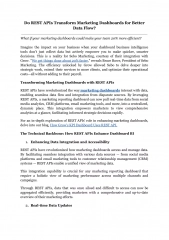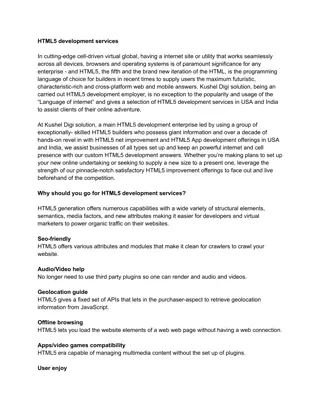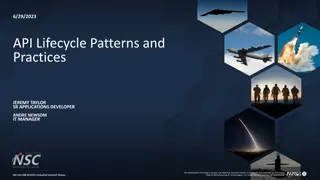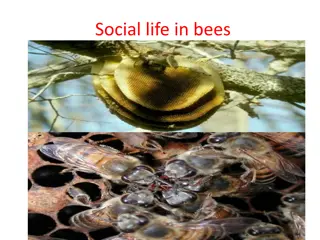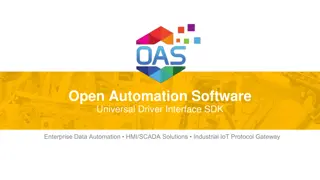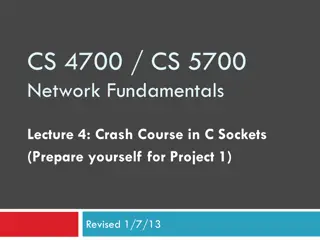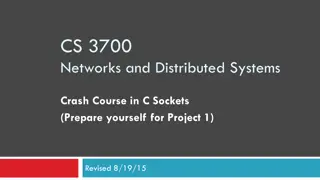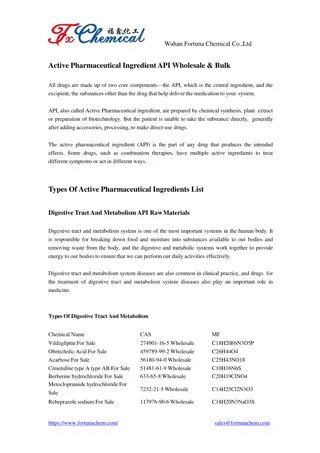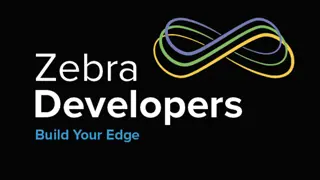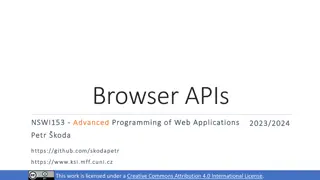
HTML5 APIs and Web Architecture
Learn about HTML5 APIs, web infrastructure, document object model, and standardization in web development. Explore the different classes of HTML5 APIs and the importance of defensive coding practices for varying browser support.
Download Presentation

Please find below an Image/Link to download the presentation.
The content on the website is provided AS IS for your information and personal use only. It may not be sold, licensed, or shared on other websites without obtaining consent from the author. If you encounter any issues during the download, it is possible that the publisher has removed the file from their server.
You are allowed to download the files provided on this website for personal or commercial use, subject to the condition that they are used lawfully. All files are the property of their respective owners.
The content on the website is provided AS IS for your information and personal use only. It may not be sold, licensed, or shared on other websites without obtaining consent from the author.
E N D
Presentation Transcript
HTML5 APIs COMP3220 Web Infrastructure COMP6218 Web Architecture Dr Nicholas Gibbins nmg@ecs.soton.ac.uk 2017-2018
HTML as application platform HTML5 APIs fall into three broad classes: 1. Document content Document Object Model, Canvas 2. Browser services XMLHttpRequest, WebSockets Web Storage, IndexedDB Web Workers 3. Hardware access Geolocation, Media Capture, Vibration, Battery Status 2
A word on standardisation Status of APIs is highly variable Some are W3C recommendations Some are WHATWG living standards Some are both (but equivalent) Some are both (but differ) Browser support is variable Write defensive code check for API support before calling it 3
Document Object Model
Document Object Model (DOM) Standard API for accessing and manipulating XML and HTML Document represented as a hierarchy of objects of type Node Root of hierarchy is an object of type Document Node interface is the key to understanding DOM Core Methods for basic access and manipulation of hierarchy Other types derived from Node add further methods Different versions of DOM for different languages Extensions of DOM Core 5
Selected Node type hierarchy Document Element Node Attr Text EntityReference 6
Node interface attributes parentNode parent Node childNodes firstChild previous Sibling this node next Sibling lastChild previousSibling nextSibling first Child last Child attributes childNodes 7
Node interface methods insertBefore(newChild, refChild) Inserts newChild into list of children after refChild replaceChild(newChild, oldChild) Replaces oldChild in list of children with newChild removeChild(oldChild) Removes oldChild from list of children appendChild(newChild) Adds newChild to the end of the list of children cloneNode(deep) Returns a duplicate of the node (which may be a deep copy) 8
Document interface methods getElementsByTagName(tagname) Get a list of all elements with the given tag name getElementById(elementId) Get the element with the given ID createElement(tagName) createAttribute(name) createTextNode(data) createEntityReference(name) 9
Element interface methods getAttribute(name) Returns value of named attribute setAttribute(name, value) Sets value of named attribute getElementsByTagName(name) Get a list of all descendant elements with the given tag name 10
Canvas 2D Context API for drawing graphics via JavaScript Uses <canvas> element as container for 2d context Animation via JavaScript (compare with declarative animation in SVG) 12
Canvas example canvas.html <!DOCTYPE html> <html> <head> <title>Canvas example</title> </head> <body> <canvas id='canvas' width='600' height='300'> Canvas not supported </canvas> <script src='canvas.js'></script> </body> </html> fallback content external script 13
Canvas example canvas.js var canvas = document.getElementById('canvas'); var context = canvas.getContext('2d'); context.fillStyle = 'red'; context.fillRect(10,10,110,60); context.font = '32pt Lucida Sans'; context.strokeStyle = 'blue'; context.strokeText("Lorem Ipsum", 40, 40); 14
XMLHttpRequest API for fetching representations of resources Asynchronous Register onload handler function for response AJAX Asynchronous JavaScript and XML 16
XMLHttpRequest example function handler() { if (this.status == 200 && this.responseXML != null { // success } else { // failure } } var client = new XMLHttpRequest(); // Register handler client.onload = handler; // Construct request client.open("GET", http://example.org/srv"); // Send request client.send(); 17
Web Sockets Three issues with XMLHttpRequest: 1. Connection is not persistent Repeated requests require TCP setup and teardown 2. Communication always initiated by client No pushing of messages from the server 3. Bound only to HTTP/HTTPS Web Sockets is a modern replacement for XMLHttpRequest Supports multiple transport protocols 19
Web Sockets example var connection = new WebSocket('ws://example.org/srv', [ http', 'xmpp']); connection.onmessage = function (e) { console.log('Server: ' + e.data); }; connection.send('...data...'); 20
Web Storage Cookies used to store key-value data in the browser HTTP-based mechanism (Cookie: header) Breaks stateless nature of HTTP Web Storage is a more principled replacement Separate storage area for each origin (web page) Non-persistent storage (Window.sessionStorage) Persistent storage (Window.localStorage) 22
Web Storage example localStorage.setItem('email', 'fred@example.org'); localStorage.getItem('visitCount'); sessionStorage.getItem('query'); 23
IndexedDB Web Storage API only useful for key-value data IndexedDB is a more sophisticated web browser database: Asynchronous Transaction support Structured (JSON) data (c.f. CouchDB, MongoDB, etc) 25
IndexedDB example var db; var request = indexedDB.open("books"); request.onsuccess = function() { db = request.result; }; 26
IndexedDB example var trans = db.transaction("books", "readwrite"); var store = trans.objectStore("books"); store.put({title: "HTML5 for Dummies", isbn: 123456}); store.put({title: "Starting HTML5", isbn: 234567}); store.put({title: "HTML5 Revealed", isbn: 345678}); trans.oncomplete = function() { // Called when all requests have succeeded // (the transaction has committed) }; 27
Web Workers Trend in Web scripting is towards asynchrony XMLHttpRequest Web Sockets Web Storage JavaScript browser environment is single-threaded Compute-intensive tasks affect responsiveness of scripts Web Workers provides multi-threading for JavaScript Asynchronous handling of results 29
Web Workers example // Main thread: var searcher = new Worker('searcher.js'); searcher.postMessage(query); searcher.onmessage = function (event) { // Process result from the worker thread }; // searcher.js: onmessage = function (event) { // Process message received from the main thread }; 30
Geolocation Allows a script to determine client location One-off (getCurrentPosition()) Ongoing (watchPosition()) Location information service independent GPS GSM/CDMA Wi-Fi 32
Geolocation example navigator.geolocation.getCurrentPosition(success); function success(pos) { console.log("Latitude: " + pos.coords.latitude); console.log("Longitude: " pos.coords.longitude); } 33
Next Lecture: Cascading Style Sheets

